When evaluating home loan refinancing, you’ll find a range of options designed to meet various financial needs. Fixed-rate refinancing offers predictability with stable monthly payments, while adjustable-rate refinancing might start with lower payments that can change over time. If you need access to cash, cash-out refinancing could be the way to go. Specialized options like FHA, VA, and USDA refinancing provide tailored solutions with potentially lower costs. There’s also no-closing-cost and interest-only refinancing to examine, each with its own set of benefits and risks. So, which option aligns best with your financial goals?
Fixed-Rate Mortgage Refinancing
Fixed-rate mortgage refinancing offers a predictable and stable option for homeowners looking to restructure their loans. If you’re aiming for consistency in your monthly payments, this might be the perfect route for you.
With a fixed-rate refinance, your interest rate remains unchanged for the entire term of the loan. This means you won’t have to worry about fluctuating market rates impacting your budget.
When you opt for a fixed-rate refinance, you can lock in a lower interest rate if the current rates are better than what you initially had. This can lead to substantial savings over the life of the loan. Additionally, it provides you with a clear financial roadmap, making it easier to plan for the future.
Fixed-rate mortgages typically come in 15, 20, or 30-year terms, giving you flexibility in choosing the duration that best fits your financial goals.
If stability and predictability are your top priorities, avoiding the uncertainty of variable rates, then fixed-rate mortgage refinancing is likely your best bet. It simplifies budgeting and helps you avoid surprises, ensuring you stay on track with your financial planning.
Adjustable-Rate Mortgage Refinancing
Adjustable-rate mortgage (ARM) refinancing offers a dynamic alternative for homeowners who are comfortable with some level of risk in exchange for potentially lower initial interest rates.
When you choose an ARM, your interest rate is fixed for an initial period, often 5, 7, or 10 years. After this period, the rate adjusts periodically based on a specific index plus a margin.
One of the main advantages is the lower starting interest rate compared to fixed-rate mortgages. This can mean lower monthly payments at first, freeing up cash for other expenses or investments.
If you plan to sell your home or refinance again before the initial fixed-rate period ends, an ARM can be a smart choice.
However, it’s important to understand the risks. Once the initial period is over, your rate can increase, sometimes considerably.
This means your monthly payments could go up, potentially straining your budget. Make sure you’re financially prepared for these adjustments.
Cash-Out Refinancing
While adjustable-rate mortgage refinancing offers flexibility with its initial lower interest rates, another popular refinancing option to evaluate is cash-out refinancing. This approach allows you to refinance your mortgage for more than you currently owe and take the difference in cash.
It’s vital to leverage your home equity to obtain funds for other financial needs.
With cash-out refinancing, you can use the extra money for various purposes, like home improvements, paying off high-interest debt, or funding significant expenses such as education or medical bills. It’s a strategic move if you need liquidity and prefer consolidating your debt into a single, potentially lower-interest loan.
The process involves applying for a new mortgage that replaces your existing one and provides you with cash up to the allowable limit.
Keep in mind that by increasing your loan balance, you may extend your loan term or raise your monthly payments. It’s important to evaluate the new terms and verify they align with your financial goals.
Cash-out refinancing can be a powerful tool, but it’s imperative to use it wisely. Make sure you understand the implications and weigh the benefits against potential risks before proceeding.
FHA Streamline Refinancing
One of the simplest ways to refinance your mortgage is through FHA Streamline Refinancing, designed specifically for homeowners with existing FHA loans. This option allows you to refinance without the hassle of a full credit check or extensive documentation.
If you’re looking to lower your interest rate or adjust your loan term, FHA Streamline could be your answer. You won’t need to worry about an appraisal, which can save you both time and money.
The main requirement is that you must already have an FHA loan and be current on your payments. Lenders like this option because it reduces their risk, making the approval process quicker and easier for you.
Another benefit is that FHA Streamline Refinancing often comes with lower closing costs compared to other refinancing options. Plus, if your loan is fairly recent, you might even qualify for an upfront mortgage insurance premium refund.
However, remember that you can’t take out any cash with this type of refinancing.
VA Loan Refinancing
If you’re a veteran or an active-duty service member, VA Loan Refinancing could be an excellent option for you. With VA refinancing, you can take advantage of lower interest rates, which could reduce your monthly payments and save you money over the life of your loan.
The two primary types of VA refinancing are the Interest Rate Reduction Refinance Loan (IRRRL) and the VA Cash-Out Refinance Loan.
The IRRRL, often referred to as a "VA streamline refinance," is designed to simplify the refinancing process. It allows you to refinance an existing VA loan to a lower interest rate with minimal paperwork, no appraisal, and no income verification.
This option is perfect if you’re looking to reduce your interest rate quickly and with little hassle.
On the other hand, the VA Cash-Out Refinance Loan lets you replace your current mortgage with a new VA loan while tapping into your home’s equity. This can be useful if you need funds for home improvements, debt consolidation, or other significant expenses.
Unlike the IRRRL, this option is open to both existing VA loan holders and those with non-VA loans.
USDA Loan Refinancing
Steering USDA Loan Refinancing can open up new opportunities for homeowners in rural areas. If you have a USDA loan, refinancing might help you lower your interest rate, reduce your monthly payments, or switch from an adjustable-rate mortgage to a fixed-rate one.
The USDA Streamlined Assist Refinance is a popular option because it doesn’t require a new appraisal or a credit review, simplifying the process considerably. To qualify, you need to have made on-time payments for the last 12 months, and your new loan must offer a tangible benefit, such as lower monthly payments.
The USDA also offers a Non-Streamlined Refinance option, which might require a new appraisal but allows for more flexibility in loan terms.
You can also take advantage of the USDA rate-and-term refinance, which lets you adjust the loan’s term lengths. This option can be particularly beneficial if you’re looking to extend the repayment period to lower monthly payments or shorten it to reduce overall interest costs.
No-Closing-Cost Refinancing
No-closing-cost refinancing can be a game-changer for homeowners looking to refinance their mortgage without the burden of upfront fees. Instead of paying thousands of dollars in closing costs at the time of refinancing, you can roll these costs into the loan balance or opt for a slightly higher interest rate. This approach lets you keep more cash on hand for other expenses or investments.
When you choose no-closing-cost refinancing, you’re effectively spreading the closing costs over the life of your loan. While this means you’ll pay more in interest over time, it can be a smart move if you’re short on cash or planning to sell your home before the increased interest considerably impacts you.
However, it’s vital to crunch the numbers. Compare the total costs of a no-closing-cost refinance with a traditional refinance to see which option saves you more money in the long run.
Look out for lenders who may try to hide fees or offer less favorable terms as part of the deal.
Interest-Only Refinancing
While no-closing-cost refinancing helps you avoid upfront fees, another option worth considering is interest-only refinancing.
With interest-only refinancing, you pay only the interest on your mortgage for a set period, typically between 5 to 10 years. This can lower your monthly payments considerably, freeing up cash for other expenses or investments.
Interest-only refinancing is particularly beneficial if you expect your income to increase in the future or if you plan to sell your home before the interest-only period ends. It provides financial flexibility since you’re not locked into high payments immediately.
However, you should be aware that once the interest-only period concludes, your payments will increase because you’ll start repaying the principal.
This option isn’t without risks. If your home’s value decreases, you could owe more than it’s worth.
Plus, if you don’t manage your finances wisely during the interest-only period, you might find it challenging to handle the higher payments later.
It’s essential to have a solid financial plan and understand the terms of your loan thoroughly.
Frequently Asked Questions
How Can I Improve My Credit Score Before Refinancing My Home Loan?
You can improve your credit score before refinancing by paying down your debts and making all your payments on time.
Check your credit report for errors and dispute any inaccuracies.
Avoid opening new credit accounts and keep your credit utilization low.
If possible, become an authorized user on someone’s account with a good history.
These strategies can boost your score and help you secure better refinancing terms.
What Are the Tax Implications of Refinancing a Home Loan?
Refinancing your home loan can impact your taxes in a few ways.
If you use the new loan to make significant home improvements, you might be able to deduct the interest. However, if you take cash out, that portion isn’t deductible.
Be mindful of points paid during refinancing; they’re generally deductible over the life of the loan, not all at once.
Always consult a tax advisor to understand your specific situation.
How Do I Determine the Break-Even Point for Refinancing Costs?
In order to determine your break-even point for refinancing costs, you’ll first need to calculate your total refinancing expenses.
Then, divide those costs by the monthly savings you’ll gain from the new loan. For example, if your refinancing costs are $3,000 and you save $150 a month, you’d break even in 20 months.
It’s crucial to evaluate how long you plan to stay in the home to see if refinancing makes sense.
Can I Refinance a Home Loan if I Have an Existing Second Mortgage?
Yes, you can refinance a home loan even if you’ve got an existing second mortgage.
However, you’ll need to get approval from your second mortgage lender. They might require you to "subordinate" the second mortgage, making certain the new primary loan takes precedence.
It’s important to contact your lenders early in the process to understand their requirements and guarantee a smooth refinancing experience.
Don’t forget to compare rates and terms!
What Impact Does Refinancing Have on My Home Equity?
Refinancing your home loan can have a significant impact on your home equity.
When you refinance, you’re fundamentally replacing your old loan with a new one. If you cash out during refinancing, you might reduce your home equity because you’re taking out some of the value.
However, if the new loan has better terms, you could build equity faster by paying off your principal more efficiently.
Conclusion
Choosing the right home loan refinancing option can greatly impact your financial future. Whether you prefer the stability of a fixed-rate mortgage, the initial savings of an adjustable-rate loan, or the liquidity of cash-out refinancing, there’s something for everyone. Specialized options like FHA, VA, and USDA loans offer unique benefits, while no-closing-cost and interest-only refinancing provide added flexibility. Evaluate your financial situation and goals carefully to make the best decision for your needs.




